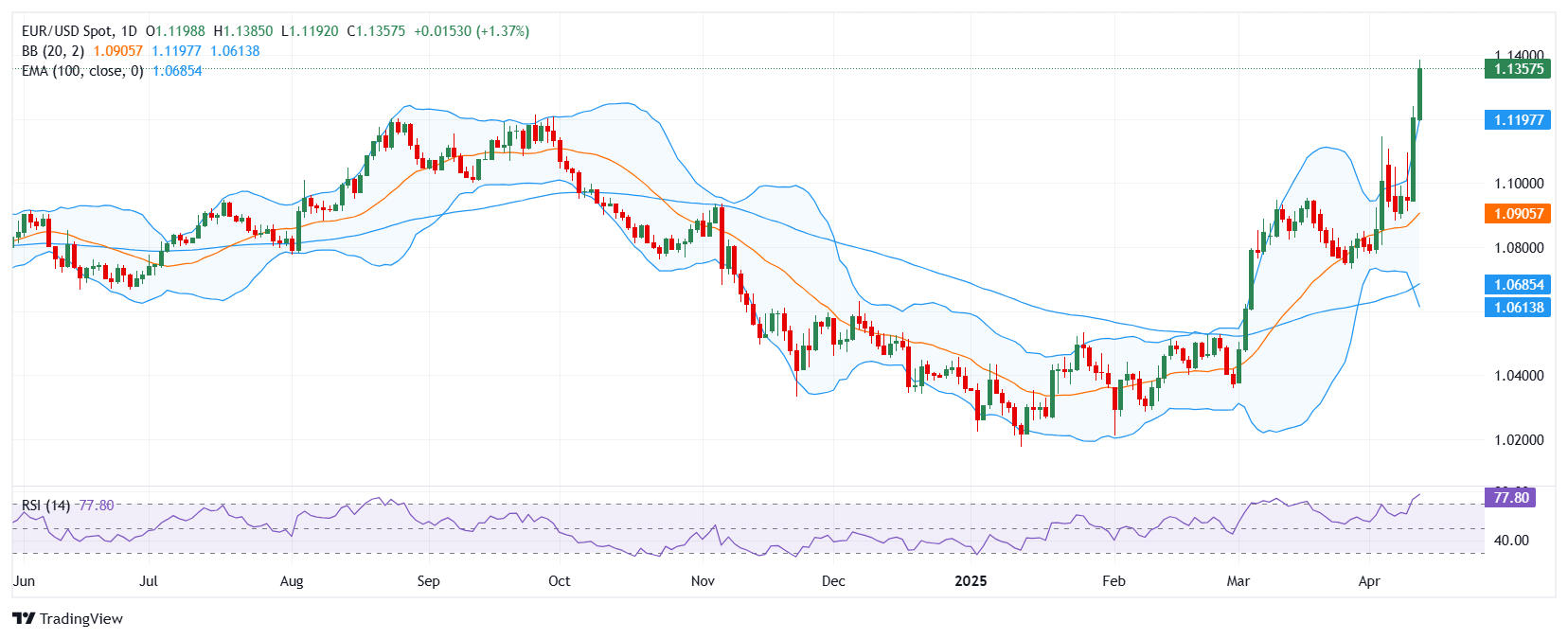EUR/USD extends gains as EU suspends retaliatory tariffs on US goods
- EUR/USD remains firm around 1.1350 in Friday’s early European session.
- The EU has paused its retaliatory 25% tariffs on US goods for 90 days due to Trump's tariff suspension.
- ECB is anticipated to cut the deposit rate at its April meeting next week amid downside risks to the economy.
The EUR/USD pair remains firm near 1.1350 after retreating from 1.1385, the highest since February 2022, during the early European trading hours on Friday. The Euro (EUR) edges higher against the US Dollar (USD) as the European Union (EU) announced a 90-day pause on countermeasures against the United States (US), a day after US President Donald Trump hit a pause on previously announced tariffs for dozens of countries.
Nonetheless, the rising expectation of more interest rate cuts from the European Central Bank (ECB) might exert some selling pressure on the shared currency. The ECB has cut the key deposit rate six times since June 2024 and is expected to cut again next week, according to 61 of 71 economists in the April 7-9 Reuters poll. "We expect the ECB to deliver a 25bp rate cut at the April meeting," noted economists at Morgan Stanley.
Investors brace for the US Producer Price Index (PPI) for March and the advanced Michigan Consumer Sentiment report, which are due later on Friday. Also, Federal Reserve (Fed) Bank of St. Louis President Alberto Musalem and Fed Bank of New York President John Williams are scheduled to speak. If the reports show a stronger-than-expected outcome, this could lift the Greenback and cap the upside for EUR/USD.
Technical Analysis: EUR/USD maintains a bearish tone amid the overbought condition
EUR/USD trades stronger on the day. The major pair keeps the bullish vibe on the daily timeframe, with the price holding above the key 100-day Exponential Moving Averages (EMA). However, the 14-day Relative Strength Index (RSI) stands near 75.50, indicating the overbought RSI condition. This suggests that a consolidation or retracement cannot be ruled out before positioning for any near-term EUR/USD appreciation
The immediate resistance level for EUR/USD emerges at 1.1385, the high of February 17, 2022, en route to the 1.1400 psychological level.
On the flip side, the initial support level for the major pair is located at 1.1146, the high of April 3. A breach of this level could expose 1.1088, the low of April 8. Further south, the next contention level to watch is 1.0780, the low of April 2.

Euro FAQs
The Euro is the currency for the 19 European Union countries that belong to the Eurozone. It is the second most heavily traded currency in the world behind the US Dollar. In 2022, it accounted for 31% of all foreign exchange transactions, with an average daily turnover of over $2.2 trillion a day. EUR/USD is the most heavily traded currency pair in the world, accounting for an estimated 30% off all transactions, followed by EUR/JPY (4%), EUR/GBP (3%) and EUR/AUD (2%).
The European Central Bank (ECB) in Frankfurt, Germany, is the reserve bank for the Eurozone. The ECB sets interest rates and manages monetary policy. The ECB’s primary mandate is to maintain price stability, which means either controlling inflation or stimulating growth. Its primary tool is the raising or lowering of interest rates. Relatively high interest rates – or the expectation of higher rates – will usually benefit the Euro and vice versa. The ECB Governing Council makes monetary policy decisions at meetings held eight times a year. Decisions are made by heads of the Eurozone national banks and six permanent members, including the President of the ECB, Christine Lagarde.
Eurozone inflation data, measured by the Harmonized Index of Consumer Prices (HICP), is an important econometric for the Euro. If inflation rises more than expected, especially if above the ECB’s 2% target, it obliges the ECB to raise interest rates to bring it back under control. Relatively high interest rates compared to its counterparts will usually benefit the Euro, as it makes the region more attractive as a place for global investors to park their money.
Data releases gauge the health of the economy and can impact on the Euro. Indicators such as GDP, Manufacturing and Services PMIs, employment, and consumer sentiment surveys can all influence the direction of the single currency. A strong economy is good for the Euro. Not only does it attract more foreign investment but it may encourage the ECB to put up interest rates, which will directly strengthen the Euro. Otherwise, if economic data is weak, the Euro is likely to fall. Economic data for the four largest economies in the euro area (Germany, France, Italy and Spain) are especially significant, as they account for 75% of the Eurozone’s economy.
Another significant data release for the Euro is the Trade Balance. This indicator measures the difference between what a country earns from its exports and what it spends on imports over a given period. If a country produces highly sought after exports then its currency will gain in value purely from the extra demand created from foreign buyers seeking to purchase these goods. Therefore, a positive net Trade Balance strengthens a currency and vice versa for a negative balance.

